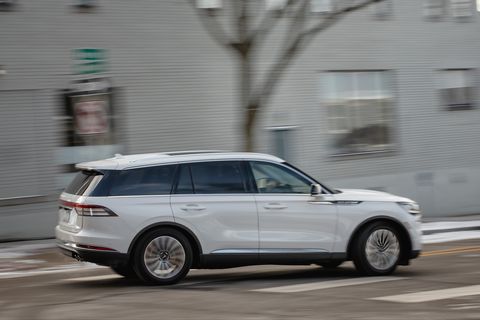
Michael SimariCar and Driver
When Ford Motor Company announced the CD6 platform that would underpin the 2020 Lincoln Aviator and Ford Explorer would have a longitudinal engine arrangement and available rear-wheel drive, we started daydreaming about drifting a twin-turbo V-6 SUV. Not everything that seems possible in your head actually plays out, though. So, when Lincoln told us a rear-drive Aviator was on its way to the office, we decided to find out if reality could match our fantasy.
Spoiler alert: We tried, but it wouldn’t go full drift king. There’s simply no way to dial back the electronic safety aids. Stability control is always lurking in the background, ready to knock off your best Ken Block act. This Lincoln is a family vehicle. There are kids in the second and third row, and one of those kids isn’t even yours. So, forget about exiting corners with any hint of aggression. Don’t even try it. Is your last name Unser or Andretti? No? Well, chill. However, this latest Aviator did corner at a stability-control-limited 0.85 g on its 20-inch wheel and tire package, up from 0.82 g that we achieved with a top-trim Black Label on 22s.
Now, the intended use for an Aviator is to haul a family around in sumptuous luxury, and it does that quite well. The opening bid for an Aviator Reserve such as ours, which is one trim-level rung up from entry level, is $57,285. Our modestly equipped test car added a $4930 bundle of driver and safety-assist systems, heated and ventilated seats for the first and second rows, and a panoramic roof. The 30-way Perfect Position and massaging seats—part of the $3300 Luxury package—take some time to adjust, but once you find the sweet spot, total comfort is achieved. Just remember to store the setting. A 28-speaker Revel Ultima audio system has crisp delivery and the bandwidth to administer serene ocean vibes as well as face-melting solos, and the aluminum speaker grates polish off the Aviators extremely posh interior. Families will love it.
We did like the standard steel spring and passive damper setup. Lincoln offers a $3000 suspension upgrade called the Dynamic Handling package that includes adaptive dampers, air springs, and variable-assist steering. After driving the base suspension setup, we think we’d save the money. The standard suspension soaks up flawed surfaces and provides adequate body control for a hefty three-row utility vehicle—we’ll keep the sport out of this—and never exhibits the floating sensation we experienced with the Dynamic option.
At the test track, the 4932-pound Aviator lacks the stick-you-to-the-seat thrust that the 400 horsepower and 415 lb-ft of torque suggest. A dash to 60 mph in 5.4 seconds and a quarter-mile time of 14.0 seconds is 0.5 second quicker than the all-wheel-drive Aviator Black Label we’ve previously tested, partially because this lower-spec model was almost 300 pounds lighter. But in a recent comparison test of German competitors, the Aviator would have fallen behind the class leaders in a drag race. The new Audi Q7, the BMW X5 xDrive40i, and Mercedes-Benz GLE450 are a few ticks quicker than the Lincoln. At least the 162-foot stop from 70 mph is good enough to put it up against the German stuff wearing summer rubber. If you’re getting the idea that the Aviator is all about stopping speed, you’re onto it. If you need more three-row punch in an American SUV and are willing to sacrifice some luxury, check out the Ford Explorer ST.
We weren’t surprised that the rear-drive Aviator proved to be less than ideal one snowy morning as its all-season Michelin Primacy tires fought for meaningful traction. This problem would certainly be remedied with a set of quality winter rubber instead of the standard all-season tires. For folks whose leather shoes are stained with salt, we’d suggest at least considering the $2510 all-wheel-drive system.
After 900 miles of city and highway driving, the Aviator returned 18 mpg, missing the EPA’s estimate by 3 mpg. Certainly, our search for the coveted rear-drive experience did not benefit our overall fuel economy, but even in our steady 75-mph highway fuel-economy test, the Aviator returned 22 mpg, missing the EPA’s highway number by 4 mpg.
While the Aviator may have thought better of our immature notions, there’s still a lot to like. It looks fantastic both inside and out—even at $16,080 less than our Black Label test car—and never makes you think about its platform-mate, the Ford Explorer. We think it’s Lincoln’s best design and execution in decades. But it’d be even better if Lincoln would just let us play a little.
Source: Reviews - aranddriver.com







